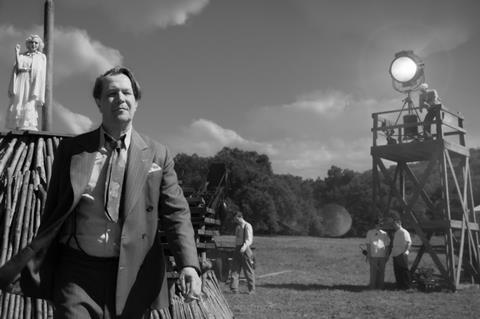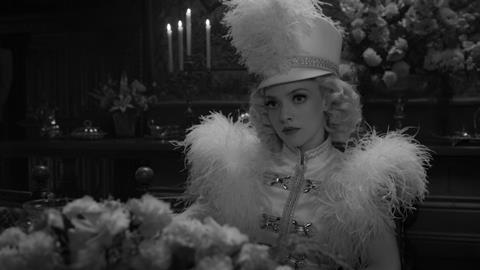In the reductive world of Hollywood, Amanda Seyfried was apt to be typecast by her mainstream musicals and comedies — so she’s winning whole new attention with her performance in David Fincher’s Mank. Dan Jolin talks to her about her revelatory work
If anyone expressed surprise at Amanda Seyfried being cast by David Fincher in Mank, they would have been no more agog than Seyfried herself.
“The whole thing was surprising,” she says. “A, that I was even being considered. B, that it was this black-and-white film that I didn’t even know was about to shoot, with David Fincher jumping into that world. It was completely out of left-field. Very shocking. Too good to be true.”
But if you think about the role she was offered (without needing to audition, by the way — “it was a conversation with David, that was it”), the surprise subsides.
Concerning the problematic threads of reality with which Herman J Mankiewicz (Gary Oldman) wove Citizen Kane, Mank devotes a portion of its narrative attention to widely misunderstood Jazz Age starlet Marion Davies: the luminous chorus girl discovered by newspaper magnate William Randolph Hearst, who expressed his love by facilitating her screen career. Despite her talent and philanthropic endeavours, however, Davies’ reputation became irreparably entangled in her unflattering association with Kane character Susan Alexander — the titular Hearst surrogate’s second wife, elevated far beyond her ability by egregious nepotism.
“People assume Marion Davies is like Susan Alexander,” says Seyfried. “But she totally isn’t. They weren’t similar at all. David has opened up this space for people to understand that Marion was very generous and very guileless and very smart. Hopefully people that see this movie will think of her completely differently.”
It is having the same effect on Seyfried herself. Just as Mank makes clear Davies should never be dismissed as a “blonde Betty Boop” (to quote one snarky contemporary), it also highlights the fact there is far more to Seyfried than we might have assumed from her higher-profile movies, from Mean Girls to Mamma Mia!. While there is no denying the success and scale of her previous work, Mank is a far richer, heftier affair, giving her material that has revealed impressive new shades to Seyfried.
“Oh, it’s been absolutely unprecedented for me,” she agrees, “and I’m loving every second of it. I’m absolutely capitalising on this moment. It’s not that I didn’t know I could do it, and it’s not that other people in the industry didn’t trust me. It’s just that there are lists. There are always lists. And depending on how many people in the industry are seeing and appreciating what you’re doing, you can go up and down those lists. It’s fickle.”
Twenty-odd years into her career, Seyfried assures us she is well used to the way Hollywood works, having made her decisions “based on trying to skate through”. But the
Netflix-backed Mank is different. “It’s moved me up a little bit, which is great,” she says. “The people that are in control of the opportunities that come my way are seeing a different weight, a different texture.”
Building rapport

Reaching this new level has been, she reveals, a broadly pleasant experience. Having worked before with Gary Oldman (on Catherine Hardwicke’s Red Riding Hood), she says she was not as intimidated by him as she
otherwise might have been. They had “an easy relationship” on set. Similar to Marion and Mank’s, even. “The thing that she and men had — which I think Gary and I have in spades — is that we have this rapport where we just say it like it is, and we can laugh at everything, really. Including ourselves.”
Seyfried clicked with Fincher, too. During that first conversation, she says, “He talked about everything — why he was making it, that it was going to be with Netflix, that he was going to shoot it in black-and-white, the freedom he was going to have… My big fear was that I wasn’t going to be able to make an impression on him if he kept doing all the talking! But by the end of the meeting we were discussing schedules. I was like, ‘I guess I’m doing it.’”
Even Fincher’s notorious predilection for multiple takes, often ranging into the hundreds, did not faze her. “It’s something I didn’t know I needed as much as I do. Only in a play have I ever been given that much time and space to explore something,” she says. “Whatever he was looking for, he was very articulate about it, take to take. I felt very supported and safely guided down the path. Even when I was freezing, even when it was 8am and I was barefoot walking on cold stone, that was exactly where I needed to be. He helped me get my best performance. He’s known for doing a lot of takes. And he’s known for getting brilliant performances from his actors. You can’t have one without the other, I think.”
Given that Mank was the last thing Seyfried shot before Los Angeles went into lockdown, she has been kept busy with the birth of her second child. It remains to be seen exactly how she will build on the Fincher film. But it is not like she has a focused career strategy: “Anybody with a plan is probably more disappointed than not,” she says.
Her two previous films, shot back to back, have yet to be released. One is Shari Springer Berman and Robert Pulcini’s domestic thriller Things Heard & Seen. The other is A Mouthful Of Air, directed by her “dear friend” Amy Koppelman, which concerns post-partum depression. “It’s very heavy and very real,” says Seyfried. She has no idea when either will come out, but describes both as similarly “special and wonderful” experiences to Mank. Perhaps they, too, will show new sides to the actress. “I guess my only plan was not to get pigeonholed,” she reflects. A plan which, it seems, is going well.
“Yeah, I think so. But everything fluctuates, you know? And the box office has so much to do with what opportunities come your way, which is just a bummer. But sometimes people take a chance on you. And I got lucky.”


























No comments yet